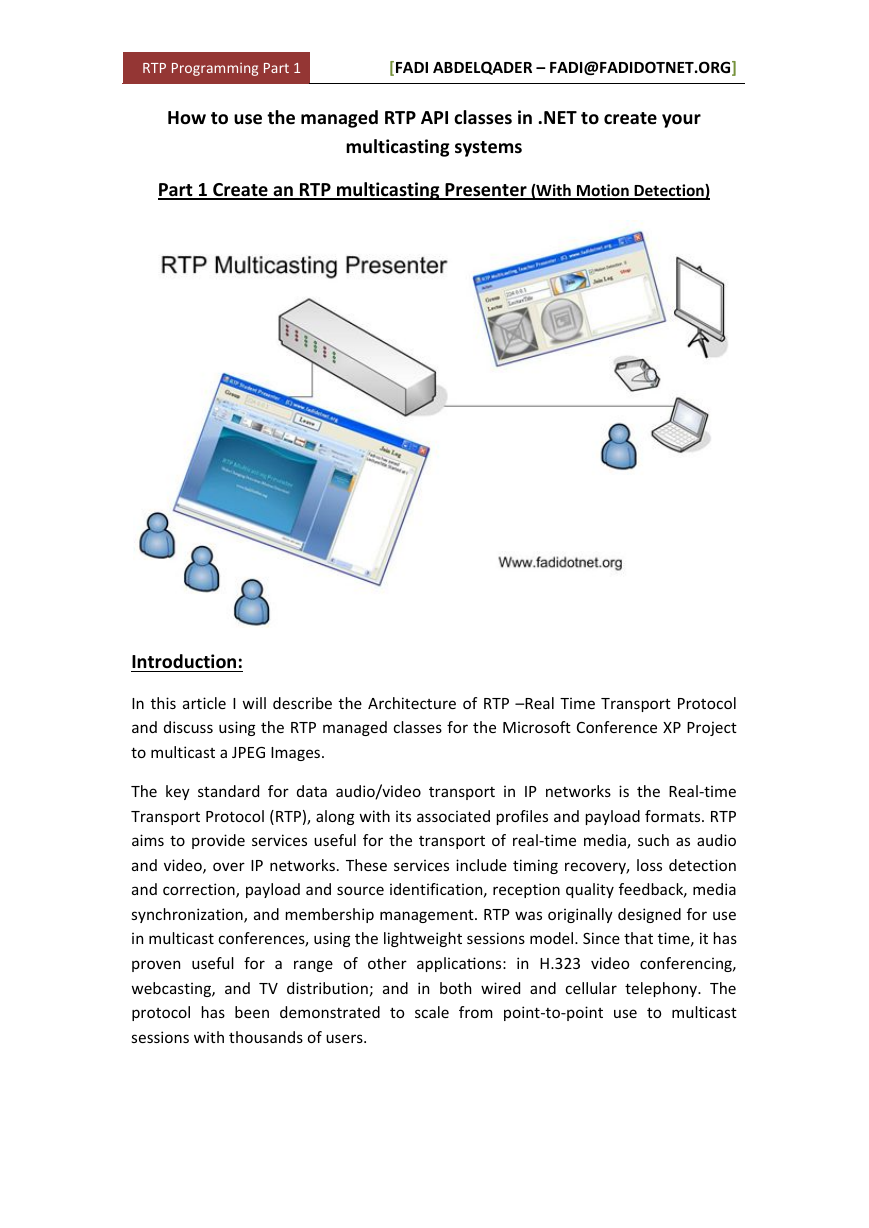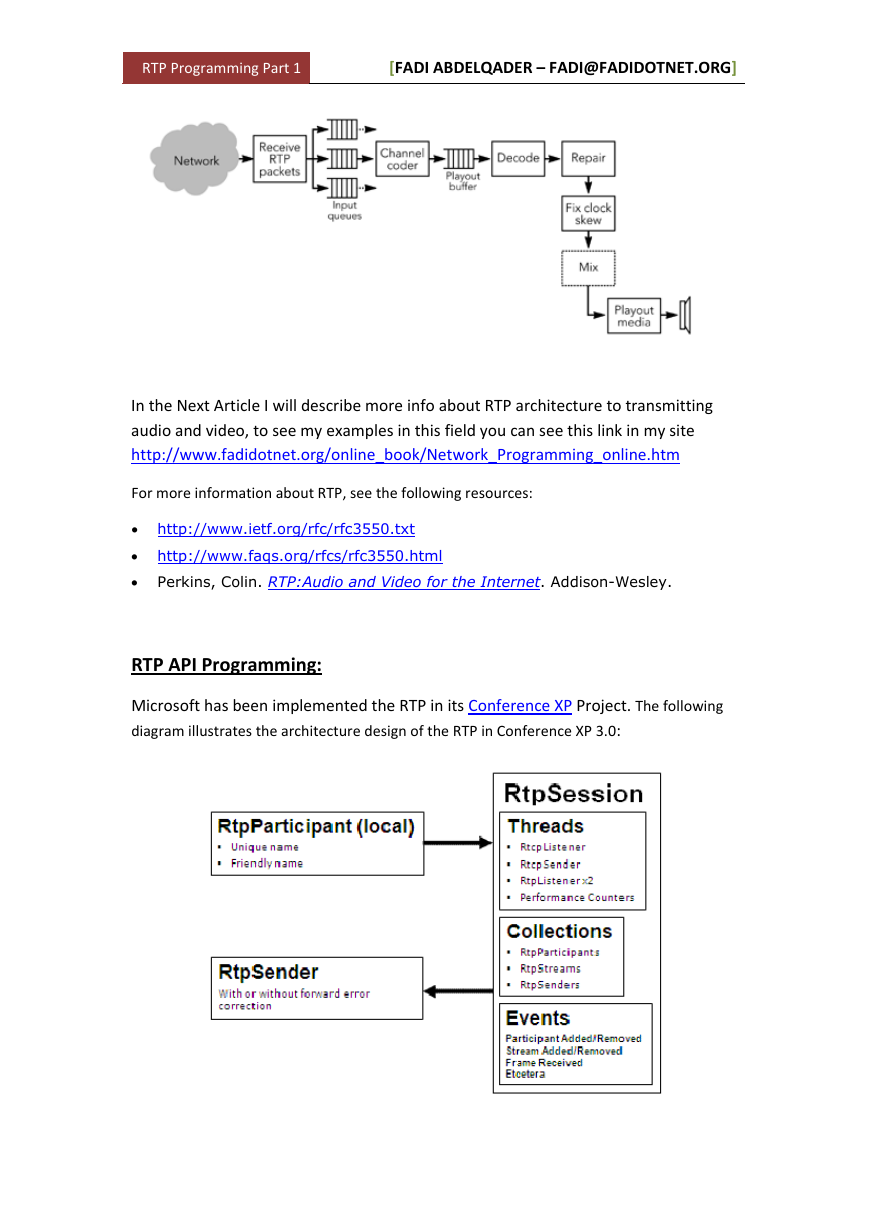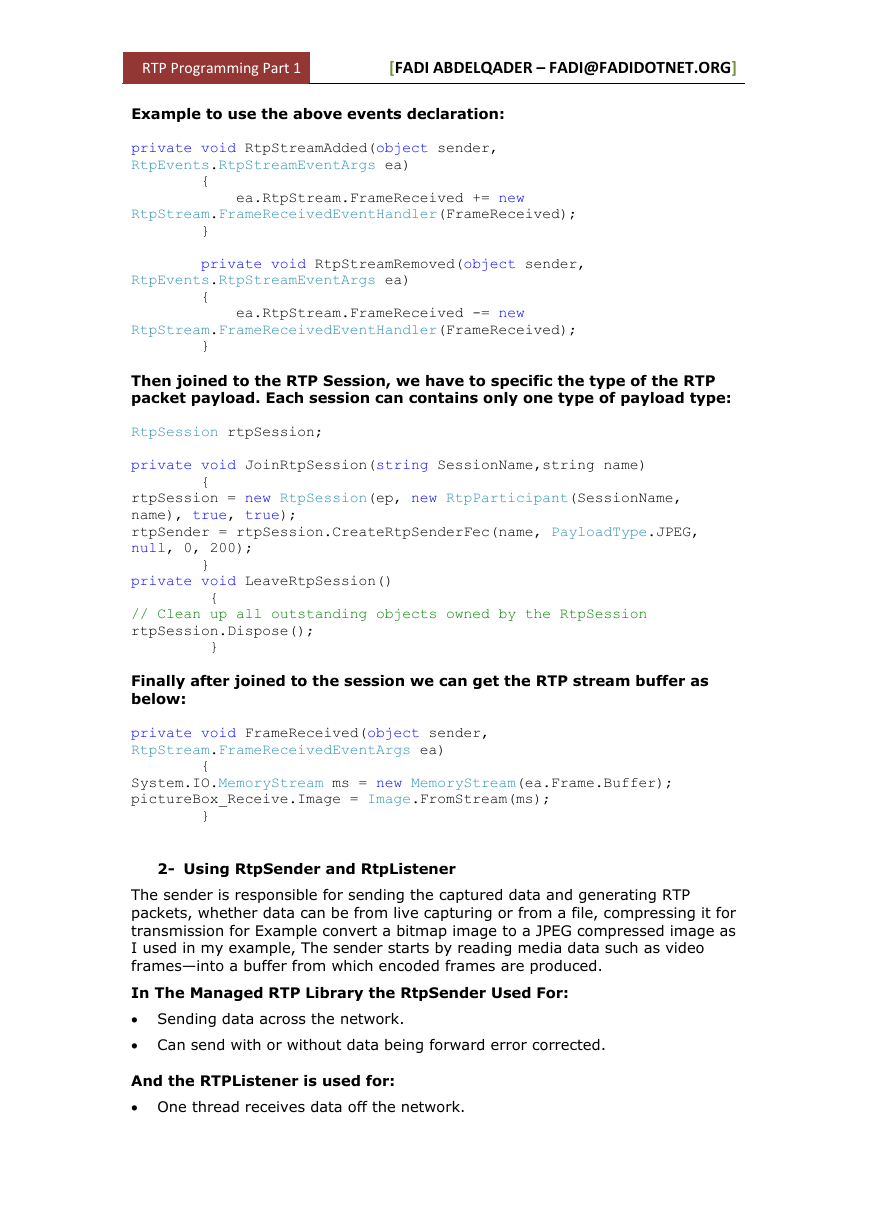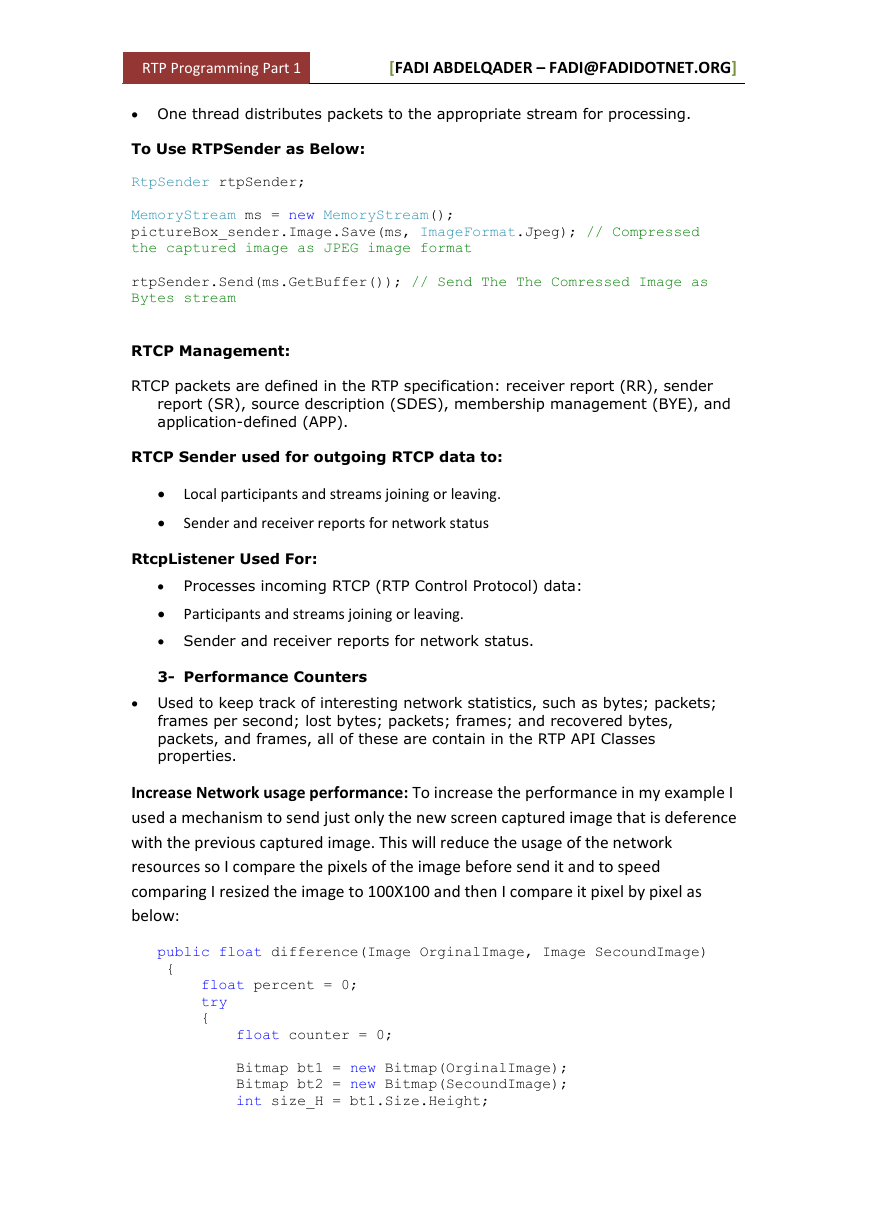RTP Programming Part 1
[FADI ABDELQADER – FADI@FADIDOTNET.ORG]
How to use the managed RTP API classes in .NET to create your
multicasting systems
Part 1 Create an RTP multicasting Presenter (With Motion Detection)
Introduction:
In this article I will describe the Architecture of RTP –Real Time Transport Protocol
and discuss using the RTP managed classes for the Microsoft Conference XP Project
to multicast a JPEG Images.
The key standard for data audio/video transport in IP networks is the Real‐time
Transport Protocol (RTP), along with its associated profiles and payload formats. RTP
aims to provide services useful for the transport of real‐time media, such as audio
and video, over IP networks. These services include timing recovery, loss detection
and correction, payload and source identification, reception quality feedback, media
synchronization, and membership management. RTP was originally designed for use
in multicast conferences, using the lightweight sessions model. Since that time, it has
proven useful for a range of other applicaons: in H.323 video conferencing,
webcasting, and TV distribution; and in both wired and cellular telephony. The
protocol has been demonstrated to scale from point‐to‐point use to multicast
sessions with thousands of users.
�
RTP Programming Part 1
How does RTP work?
[FADI ABDELQADER – FADI@FADIDOTNET.ORG]
A sender is responsible for capturing and transforming audiovisual data for
transmission, as well as for generating RTP packets. It may also participate in error
correction and congestion control by adapting the transmitted media stream in
response to receiver feedback.
the frames will be loaded into RTP packets, ready for sending. If frames are large,
they may be fragmented into several RTP packets; if they are small, several frames
may be bundled into a single RTP packet. Depending on the error correction scheme
in use, a channel coder may be used to generate error correction packets or to
reorder packets before transmission.
After the RTP packets have been sent, the buffered media data corresponding to
those packets is eventually freed. The sender must not discard data that might be
needed for error correction or for the encoding process. This requirement may mean
that the sender must buffer data for some time after the corresponding packets
have been sent, depending on the codec and error correction scheme used.
The sender is responsible for generating periodic status reports for the media
streams it is generating, including those required for lip synchronization. It also
receives reception quality feedback from other participants and may use that
information to adapt its transmission.
A receiver is responsible for collecting RTP packets from the network, correcting any
losses, recovering the timing, decompressing the media, and presenting the result to
the user. It also sends reception quality feedback, allowing the sender to adapt the
transmission to the receiver, and it maintains a database of participants in the
session. A possible block diagram for the receiving process is shown in below figure;
implementations sometimes perform the operations in a different order depending
on their needs.
�
RTP Programming Part 1
[FADI ABDELQADER – FADI@FADIDOTNET.ORG]
In the Next Article I will describe more info about RTP architecture to transmitting
audio and video, to see my examples in this field you can see this link in my site
http://www.fadidotnet.org/online_book/Network_Programming_online.htm
For more information about RTP, see the following resources:
• http://www.ietf.org/rfc/rfc3550.txt
• http://www.faqs.org/rfcs/rfc3550.html
• Perkins, Colin. RTP:Audio and Video for the Internet. Addison-Wesley.
RTP API Programming:
Microsoft has been implemented the RTP in its Conference XP Project. The following
diagram illustrates the architecture design of the RTP in Conference XP 3.0:
�
RTP Programming Part 1
[FADI ABDELQADER – FADI@FADIDOTNET.ORG]
These steps will give you a brief to use RTP with your multicasting applications:
1- Using RtpSession and RtpParticipant
A session consists of a group of participants who are communicating using RTP. A
participant may be active in multiple RTP sessions—for instance, one session for
exchanging audio data and another session for exchanging video data. For each
participant, the session is identified by a network address and port pair to which
data should be sent, and a port pair on which data is received. The send and receive
ports may be the same. Each port pair comprises two adjacent ports: an even‐
numbered port for RTP data packets, and the next higher (odd‐numbered) port for
RTCP control packets. The default port pair is 5004 and 5005 for UDP/IP, but many
applications dynamically allocate ports during session setup and ignore the default.
RTP sessions are designed to transport a single type of media; in a multimedia
communication, each media type should be carried in a separate RTP session
We will use the RtpSession and RtpParticipant classes to:
• Manages all of the RTP objects and data.
• Holds information about a user.
• Required to send or receive RTP data.
To use it we have first to hook some RTP events to communicate for what is
happening in the RTP API process these are:
// Manage the join to the session Ex.Add/Remove a User To/From the
RTP Session
RtpEvents.RtpParticipantAdded += new
RtpEvents.RtpParticipantAddedEventHandler(RtpParticipantAdded);
RtpEvents.RtpParticipantRemoved += new
RtpEvents.RtpParticipantRemovedEventHandler(RtpParticipantRemoved);
Example to use the above events declarations:
private void RtpParticipantAdded(object sender,
RtpEvents.RtpParticipantEventArgs ea)
{
MessageBox.Show (ea.RtpParticipant.Name + " has joined to the
session");
}
private void RtpParticipantRemoved(object sender,
RtpEvents.RtpParticipantEventArgs ea)
{
MessageBox.Show(ea.RtpParticipant.Name + " has left the session");
}
// Manage (Add/Remove)Sessions Ex.Activeate multiple RTP sessions
RtpEvents.RtpStreamAdded += new
RtpEvents.RtpStreamAddedEventHandler(RtpStreamAdded);
RtpEvents.RtpStreamRemoved += new
RtpEvents.RtpStreamRemovedEventHandler(RtpStreamRemoved);
�
RTP Programming Part 1
[FADI ABDELQADER – FADI@FADIDOTNET.ORG]
Example to use the above events declaration:
private void RtpStreamAdded(object sender,
RtpEvents.RtpStreamEventArgs ea)
{
ea.RtpStream.FrameReceived += new
RtpStream.FrameReceivedEventHandler(FrameReceived);
}
private void RtpStreamRemoved(object sender,
RtpEvents.RtpStreamEventArgs ea)
{
ea.RtpStream.FrameReceived -= new
RtpStream.FrameReceivedEventHandler(FrameReceived);
}
Then joined to the RTP Session, we have to specific the type of the RTP
packet payload. Each session can contains only one type of payload type:
RtpSession rtpSession;
private void JoinRtpSession(string SessionName,string name)
{
rtpSession = new RtpSession(ep, new RtpParticipant(SessionName,
name), true, true);
rtpSender = rtpSession.CreateRtpSenderFec(name, PayloadType.JPEG,
null, 0, 200);
}
private void LeaveRtpSession()
{
// Clean up all outstanding objects owned by the RtpSession
rtpSession.Dispose();
}
Finally after joined to the session we can get the RTP stream buffer as
below:
private void FrameReceived(object sender,
RtpStream.FrameReceivedEventArgs ea)
{
System.IO.MemoryStream ms = new MemoryStream(ea.Frame.Buffer);
pictureBox_Receive.Image = Image.FromStream(ms);
}
2- Using RtpSender and RtpListener
The sender is responsible for sending the captured data and generating RTP
packets, whether data can be from live capturing or from a file, compressing it for
transmission for Example convert a bitmap image to a JPEG compressed image as
I used in my example, The sender starts by reading media data such as video
frames—into a buffer from which encoded frames are produced.
In The Managed RTP Library the RtpSender Used For:
• Sending data across the network.
• Can send with or without data being forward error corrected.
And the RTPListener is used for:
• One thread receives data off the network.
�
RTP Programming Part 1
[FADI ABDELQADER – FADI@FADIDOTNET.ORG]
• One thread distributes packets to the appropriate stream for processing.
To Use RTPSender as Below:
RtpSender rtpSender;
MemoryStream ms = new MemoryStream();
pictureBox_sender.Image.Save(ms, ImageFormat.Jpeg); // Compressed
the captured image as JPEG image format
rtpSender.Send(ms.GetBuffer()); // Send The The Comressed Image as
Bytes stream
RTCP Management:
RTCP packets are defined in the RTP specification: receiver report (RR), sender
report (SR), source description (SDES), membership management (BYE), and
application-defined (APP).
RTCP Sender used for outgoing RTCP data to:
Local participants and streams joining or leaving.
•
• Sender and receiver reports for network status
RtcpListener Used For:
• Processes incoming RTCP (RTP Control Protocol) data:
• Participants and streams joining or leaving.
• Sender and receiver reports for network status.
3- Performance Counters
• Used to keep track of interesting network statistics, such as bytes; packets;
frames per second; lost bytes; packets; frames; and recovered bytes,
packets, and frames, all of these are contain in the RTP API Classes
properties.
Increase Network usage performance: To increase the performance in my example I
used a mechanism to send just only the new screen captured image that is deference
with the previous captured image. This will reduce the usage of the network
resources so I compare the pixels of the image before send it and to speed
comparing I resized the image to 100X100 and then I compare it pixel by pixel as
below:
public float difference(Image OrginalImage, Image SecoundImage)
{
float percent = 0;
try
{
float counter = 0;
Bitmap bt1 = new Bitmap(OrginalImage);
Bitmap bt2 = new Bitmap(SecoundImage);
int size_H = bt1.Size.Height;
�
RTP Programming Part 1
[FADI ABDELQADER – FADI@FADIDOTNET.ORG]
int size_W = bt1.Size.Width;
float total = size_H * size_W;
Color pixel_image1;
Color pixel_image2;
for (int x = 0; x != size_W; x++)
{
for (int y = 0; y != size_H; y++)
{
pixel_image1 = bt1.GetPixel(x, y);
pixel_image2 = bt2.GetPixel(x, y);
if (pixel_image1 != pixel_image2)
{
counter++;
}
}
}
percent = (counter / total) * 100;
}
catch (Exception) { percent = 0; }
return percent;
}
The above method will calculate the deference pixels in the new captured image so
we will decide to send it or not depend on the returned percentage.
References:
1‐ Microsoft Conference XP Project www.conferencexp.net
2‐ RTP: Audio and Video for the Internet, Addison Wesley 2003
3‐ The Complete reference in network programming, FADI Abdelqader (under
writing) See: www.fadidotnet.org and also www.fadidotnet.org/vb
4‐ hp://www.ie.org/rfc/rfc3550.txt
�














 2023年江西萍乡中考道德与法治真题及答案.doc
2023年江西萍乡中考道德与法治真题及答案.doc 2012年重庆南川中考生物真题及答案.doc
2012年重庆南川中考生物真题及答案.doc 2013年江西师范大学地理学综合及文艺理论基础考研真题.doc
2013年江西师范大学地理学综合及文艺理论基础考研真题.doc 2020年四川甘孜小升初语文真题及答案I卷.doc
2020年四川甘孜小升初语文真题及答案I卷.doc 2020年注册岩土工程师专业基础考试真题及答案.doc
2020年注册岩土工程师专业基础考试真题及答案.doc 2023-2024学年福建省厦门市九年级上学期数学月考试题及答案.doc
2023-2024学年福建省厦门市九年级上学期数学月考试题及答案.doc 2021-2022学年辽宁省沈阳市大东区九年级上学期语文期末试题及答案.doc
2021-2022学年辽宁省沈阳市大东区九年级上学期语文期末试题及答案.doc 2022-2023学年北京东城区初三第一学期物理期末试卷及答案.doc
2022-2023学年北京东城区初三第一学期物理期末试卷及答案.doc 2018上半年江西教师资格初中地理学科知识与教学能力真题及答案.doc
2018上半年江西教师资格初中地理学科知识与教学能力真题及答案.doc 2012年河北国家公务员申论考试真题及答案-省级.doc
2012年河北国家公务员申论考试真题及答案-省级.doc 2020-2021学年江苏省扬州市江都区邵樊片九年级上学期数学第一次质量检测试题及答案.doc
2020-2021学年江苏省扬州市江都区邵樊片九年级上学期数学第一次质量检测试题及答案.doc 2022下半年黑龙江教师资格证中学综合素质真题及答案.doc
2022下半年黑龙江教师资格证中学综合素质真题及答案.doc